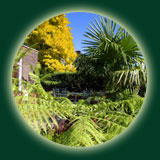 What is a sustainable play area and how is it achieved?
What is a sustainable play area and how is it achieved?SchoolPlaygroundDesigners.co.uk have a rigid code of practice in the building and sustainable maintenance of play areas. Listed below are tips and tricks that any gardener interested in sustainability should follow.











Rain water from roofs and pavements can be harvested.

It can stored either above ground in oak barrel water butts attached to drainpipes and in under ground tanks. Using these methods hundreds of gallons of water can be stores and used throughout the summer.
All garden and kitchen waste should be composted. This, as well as rotted farmyard manure is invaluable for all Sustainable Gardeners.

A good supply of Compost means there is no longer any necessity to add peat or artificial fertilisers to the ground.
A layer of mulch (such as rotted leaves straw, grass clippings, wood chips, sawdust or cocoa shells) across open soil is invaluable.

It helps retain moisture, suppress weeds, helps soil structure, stops soil erosion and protects plant roots in extremes of temperature.
The canny sustainable gardener will intersperse the plants with those which either have their own inbuilt “pest deterrents” or ones which encourage natural predators.

Popular plants in this range include Marigolds, Wild Garlic, Onions, Chives and many herbs

Weeds can be as great a bane to the Sustainable Gardener as garden pests.

Weeds take nourishment and moisture out of the soil and need to be removed as quickly as possible and definitely before they produce seed heads!
Non tidying: it is not necessary to remove all spent or dead items from a Sustainable Garden.

Piles of leaves or fallen twigs will quickly create Natural Habitats for valuable insects, invertebrates and wild life.
Constant watering of lawns in dry weather is wasteful and is not necessary for the perpetuation of a lawn.

It can quite happily turn brown but will revert to a lush green sward, after the first Autumn rains.
Wherever possible, Wild flowers should be placed in a Sustainable Garden.

They will grow in the most appalling soil conditions and they are probably “The Best Friend” of a Sustainable Gardener.
It would be unwise to plant a Coastal Tree in a sheltered Inland Valley.

One should always examine a particular area and choose Trees which are Native to that area. They settle in quicker and require less maintenance
It would be pointless to plant a Zantesdeschia (a damp and shade loving plant) in the centre of a sunny, dry area.

Sustainable Planting means keeping plants happy by putting then in conditions to which they are accustomed.
Fruit and Vegetables: home grown produce contains more essential nutrients than any which one can purchase in normal stores.

Fruit and Vegetables are pure Sustainable Gardening as after having enjoyed the produce, the Sustainable Gardener replants the seeds (potato eyes etc) and up “pops” another even bigger crop!

Where watering is required, the Sustainable Gardener should only water the essential part of a plant, which are normally the root systems.

This can be easily achieved by the hand use of a watering can or if essential, the use of a drip feed water system which delivers water directly to the root systems of each plant.
Leaving a water sprinkler “whirring” away in the middle of a lawn, on a sunny day, a large proportion of the water is being wasted by evaporation and by falling on a stone patio or a pathway.

This Input of water to the ground is not being matched by the Natural Replenishment of the water. The best time of day to water is late evening.


See the rosy-berried Spindle
All to sunset colours turning,
Till the thicket seems to kindle,
Just as though the trees were burning.
While my berries split and show
Orange-coloured seeds aglow,
One by one my leaves must fall;
Soon the wind will take them all.
Soon must fairies shut their eyes
For the Winter's hushabies;
But, before the Autumn goes,
Spindle turns to flame and rose!
